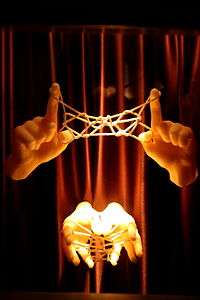Julia Averkieva
Julia Pavlovna Petrova-Averkieva (July 24, 1907 – October 9, 1980) was a Soviet anthropologist and string figure collector.[1] A student of Franz Boas,[1] and influenced by Lewis Henry Morgan,[2] she went on to serve as the director of North American Studies at the Institute of Ethnography in Moscow.[3][4] She compiled the Kwakwaka'wakw, which is recognized as "the most comprehensive Native American string figure collection ever assembled from a single tribe [or nation]."[5]
Julia Petrova-Averkieva | |
|---|---|
| Born | July 24, 1907 Poduzhemyeh, in Karelia, Russia. |
| Died | October 9, 1980 (aged 73) |
| Nationality | Russian Empire |
| Occupation | Anthropologist, ethnologist |
| Employer | Institute of Ethnography in Moscow |
Early life
Averkieva was born in 1907 in the small village of Poduzhemyeh, in Karelia, Russia. The oldest of three girls, her mother died in 1918. At that time, her father worked as a lumberjack, and worked six days a week far away from home. In order to support her family, Averkieva shouldered the responsibilities of raising her sisters, while also attending school. She learned to balance these obligations by mastering cross-country skiing, which drastically reduced her travel time between home, school, and Poduzhemyeh.[6]
Career
Averkieva was a bright pupil,[7] and her high marks assured her a position in secondary education. In May 1925, Averkieva was accepted into Leningrad State University, to study under W. G. Borgoras, an ethnologist specializing in local history. Although Averkieva proved to be an apt pupil, the University ethnologists advised her to travel across the Atlantic to study the ancient cultures of North America, where anthropology was gaining popularity. Averkieva established herself as an ethnologist under the mentorship of Franz Boas.[7]
Averkieva's destiny was sealed when she took a six-month trip to Vancouver Island to study the Kwakiutl people.[6] She was soon living among them, meticulously observing every aspect of their life and, in particular, collecting string figures. She earned the respect of the Kwakiutl, and was officially inducted into their tribe with the gift of an eagle totem.[8] Much of Averkieva's book reflects the wisdom she gained in her experience on the Northwestern Coast.[4]
References
- Averkieva, Julia P. and Sherman, Mark A. (1992). "Introduction by Mark A. Sherman", Kwakiutl String Figures Archived 2011-09-28 at the Wayback Machine, p.xvii. University of British Columbia. ISBN 978-0-7748-0432-5.
- Averkieva and Sherman (1992), p.xix.
- Averkieva and Sherman (1992), p.xx.
- "Photographs of Julia Averkieva · SOVA". Smithsonian Online Virtual Archives (SOVA). Retrieved 2019-06-29.
- Averkieva and Sherman (1992), p.xiii.
- Averkieva, Julia P. (1992-06-01). Kwakiutl String Figures. UBC Press. ISBN 9780774804325.
- Averkieva and Sherman (1992), p.xvii.
- Averkieva and Sherman (1992), p.xvii-xviii.
